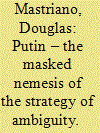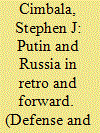|
|
|
Sort Order |
|
|
|
Items / Page
|
|
|
|
|
|
|
| Srl | Item |
| 1 |
ID:
151701


|
|
|
|
|
| Summary/Abstract |
Insurgencies thrive in regions where government legitimacy is absent. In the post-war Philippines, Captain Charles T. R. Bohannan of the Army’s Counter Intelligence Corps became actively aware of this dynamic. Bohannan is best known for his later work with Edward Lansdale and Ramon Magsaysay in defeating the Huk Rebellion (1950–1954). Here the author examines Bohannan’s early investigative work against Japanese war criminals, wartime Filipino collaborators, and the rising threat of communist subversion most associated with the Huk. All of these experiences fed into what would be the successful campaign against the Huk, chronicled in his seminal work, Counter Guerrilla Operations: The Philippines Experience, and offers lessons on the investigative (as opposed to tactical or psychological) nature of effective counter-insurgency work, as it relates to both legitimacy in governance and the rise of insurgencies.
|
|
|
|
|
|
|
|
|
|
|
|
|
|
|
|
| 2 |
ID:
151700


|
|
|
|
|
| Summary/Abstract |
This article examines the role of the Macedonian Question in the 1944 December Uprising (Dekemvriana) in Greece. While the Dekemvriana is commonly portrayed in right–left terminology in the historiography, this article argues that part of the reason for the left’s failure was their inability to manage the Macedonian ethnic component of the struggle, either within their armed forces or in their relationship with Yugoslavia. As such, this article integrates the early phases of the Greek Civil War into the broader literature on minorities in civil conflict, while simultaneously exposing some of the myths about Macedonian involvement that result from its contemporary political ramifications.
|
|
|
|
|
|
|
|
|
|
|
|
|
|
|
|
| 3 |
ID:
151705


|
|
|
|
|
| Summary/Abstract |
Recent events demonstrate the complex and adaptive approach employed by Russia to reassert influence in Europe. The changing face of Russia’s strategy commenced in 2007 when it launched a crippling cyber-attack against Estonia. This was followed by a large Russian conventional attack against Georgia in 2008, occupying two large areas of the nation. 2014 witnessed the Russian annexation of Crimea where in just a week, Russia seized control of Crimea “without firing a shot.” The annexation of Crimea was rapidly followed by a Russian inspired and led subversive war in eastern Ukraine. The common thread among these diverse Russian operations is its use of ambiguity to confound and confuse decision makers in the West.
|
|
|
|
|
|
|
|
|
|
|
|
|
|
|
|
| 4 |
ID:
151704


|
|
|
|
|
| Summary/Abstract |
Deterioration in security relations as between NATO and Russia reached boiling point in the aftermath of Russia’s annexation of Crimea in 2014 and its subsequent destabilization of Eastern Ukraine. As a result, some voices in the West look forward to the departure of Vladimir Putin from power, and others to the possible disintegration of Russia as a unitary state. However, both the departure of Putin and the collapse of Russia have a nuclear dimension. Putin has issued pointed reminders of Russia’s status as a nuclear great power, and Russian military doctrine allows for nuclear first use in the event of a conventional war with extremely high stakes. Beyond Putin, a breakup of Russia would leave political chaos in Eastern Europe, Central Asia and elsewhere, inviting ambiguous command and control over formerly Russian nuclear forces.
|
|
|
|
|
|
|
|
|
|
|
|
|
|
|
|
| 5 |
ID:
151702


|
|
|
|
|
| Summary/Abstract |
Risk management is a decision-support process and a vital tool for military planning and decision-making. Today, several nations utilize risk-based approaches to analyze the level of security in military operations. There are both strengths and challenges in applying risk-based approaches to support military decisions. In this article, the challenges related to risk communication are investigated with the aim of describing how a military organization should train to create a good environment for effective risk communication. The analysis finds that it is important for the organization to define and consistently use a shared risk understanding. Such a shared risk understanding will need a systematic development process that focuses on the future decision makers’ and analysts’ education and training. To reach understanding, all involved parties must have the chance to identify the problem, reflect on its implications, test different solutions and develop a solution.
|
|
|
|
|
|
|
|
|
|
|
|
|
|
|
|
| 6 |
ID:
151703


|
|
|
|
|
| Summary/Abstract |
The United States’ Air Force (USAF) has developed and used unmanned aerial vehicle (UAV) technology to monitor and assassinate dangerous terrorists in Afghanistan, Iraq, Libya, Pakistan, Somalia, Syria, and Yemen. Currently, there are few countries that possess armed UAV and since the US created much of this technology, the USAF is usually part of the training that automatically accompanies the purchase of its UAVs. The research question this article attempts to answer is, “What is the extent of the United States’ Air Force assistance in the training and proliferation of UAV technology to foreign militaries?”
|
|
|
|
|
|
|
|
|
|
|
|
|
|
|
|
|
|
|
|
|